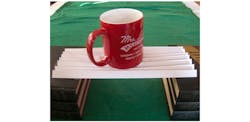Engineered for strength
Star Buildlings’ steel wall panels are designed to handle wind loads up to 145 MPH, yet the steel of these panels is seemingly thin, 1/32-inch or less. This steel helps keep the panels light in weight. However, anyone who's ever handled a thin sheet of flat steel knows that it bends very easily. How do Star Buildings steel panels achieve so much greater strength than a simple piece of flat steel? They are engineered for it.
Steel wall and roof panels are available in a variety of patterns, featuring bends or creases that produce different shadow effects and provide visual relief in the wall surface. These patterns are not merely appearance options, however. They actually make the panels significantly more rigid. Even though the bends are very small, each crease makes the panel much more resistant to bending or denting.
There’s a simple experiment you can do to see this principle in action. All you need is a sheet of printer paper, a quarter, and an assistant. First, test the case of simple, flat sheet.
1. Hold both your hands in front of you, with your fingers straight out and your palms facing each other about 8 inches apart.
2. Have your assistant lay the sheet of paper across the top edges of yours hands. If the paper bends and falls between your hands, try turning it over so it curls the other way, and see if it will hold itself up.
3. Have your assistant drop the quarter onto the piece of paper from about 8 inches up.
The paper bends and plunges to the floor!
Now, fold the paper once or twice lengthwise, open it out part way so that it is still creased, but will lay on top of your hands.
Repeat steps 1-3.
Amazingly, the quarter just bounces off the paper!
If you accordion-fold the paper a few more times, it can hold up an empty coffee cup.
The principle at work here is the same one used in the design of load-bearing cold-formed steel studs. The number of creases is the significant factor in multiplying the strength of the panel. A simple C-stud has four creases to give it strength in both lateral and in-plane loads.
This increases strength for two reasons. First, the bends act something like little tiny I-beams. Each bend separates a single flat surface into two surfaces in slightly different planes with a small space separating the planes and a strip of steel holding them in parallel. That is, in essence, and I-beam, and it is considerably more bend-resistant that flat steel.
The second reason is that the act of working the steel causes metallurgical changes in it that make it harder. Each bend works the steel a little, changing the spatial relationship of the steel molecules and making the metal more rigid.
Steel wall and roof panels, with their series of bend-details, are strong enough to meet the wind and snow codes in all 50 states. Their resilience and durability has been proven by the thousands of metal buildings, many over a half century old, that continue to give good service.

